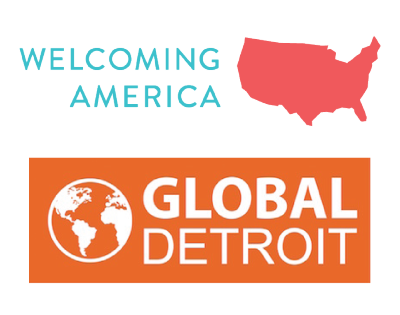New Gateway Cities: Immigration key to rebuilding Rust Belt communities
New Governing Magazine article highlights that immigration is a critical source of population growth and economic vitality for Midwest and Rust Belt cities and metros, and shows the importance of Welcoming Economies Global Network efforts in three member cities.
By Steve Tobocman
An article in this month’s Governing Magazine, the nation’s leading media platform covering politics, policy and management for state and local government leaders, highlights the work of several Welcoming Economies Global Network (WE Global) members and the importance of our work in rebuilding the Midwest and Rust Belt, as well as the importance of our region in the nation’s immigration story. Three WE Global members are featured and quoted (from Columbus, Dayton, and Detroit) and Welcoming America’s Deputy Director Rachel Peric is quoted at length.
Titled “Immigrants Establishing Roots in New Gateway Cities,” the article focuses on whether Census data can be used to evaluate initiatives in the Midwest and Rust Belt that have launched in recent years to attract immigrants to boost their economies.
“The Midwest is becoming the new gateway,” says Guadalupe Velasquez, WE Global Steering Committee member and coordinator of the New American Initiative for the City of Columbus.
Governing compared Census data collected for all U.S. cities with populations of at least 100,000. According to the article, Midwest and Rust Belt cities are experiencing a disproportionate share of immigration growth. With immigrant populations lower than the national average (and/or lower than populations in Sun Belt cities or traditional gateways), cities in the WE Global Network tend to possess some of the most rapidly growing immigrant populations.
“Cities where the foreign born make up less than a tenth of the total population recorded an average foreign-born population increase of 18 percent over the five-year period [2009-2014], compared to 7 percent in areas where they make up more than a quarter of the population,” the article states. “The 106 jurisdictions where the foreign-born accounted for less than a tenth of the total population collectively added twice as many foreign-born residents as natives.”
Many WE Global members are beginning to turn their attention to evaluating the impacts of their efforts. Impact evaluation has been a priority area for WE Global Network technical assistance and insight—the Network hosted two separate sessions on the topic during the core member day of our first three annual convenings.
Trying to use annual Census numbers to evaluate programmatic impacts in WE Global cities can be a difficult task. During the 2015 WE Global Convening in Dayton, core members heard from David Kallick of the Fiscal Policy Institute about some of the pitfalls of relying too heavily on annual Census data to try to measure interventions that WE Global members have launched in the last few years. The problem is that available data sources just don’t capture year-by-year changes in population accurately enough.
Nonetheless, the underlying trends suggested by the Governing Magazine article highlight the importance of the WE Global Network and its members—immigration is a critical source of population growth and economic vitality for Midwest and Rust Belt cities and metros.
Columbus
The article notes that Columbus was one of the nation’s earliest adopters of immigrant-friendly outreach. Officials first took up the issue in the mid-1990s, and efforts have since shifted more to capacity building and support for various organizations that serve immigrants.
According to Governing Magazine, Columbus experienced an estimated 27 percent jump in the foreign-born population between 2009 and 2014, compared to an average increase of 9 percent for cities with over a half-million residents, and about 11 percent of Columbus residents are now foreign born. Noting that this growth and immigrant population size is more than other larger cities in the WE Global region, the article again cites Guadalupe Velasquez, WE Global Steering Committee Member and Columbus New Americans Initiative Coordinator, as attributing Columbus’s early work on immigrant attraction, retention, and welcoming—along with the ample supply of jobs, affordable housing, and higher education opportunities—as factors in Columbus’ success.
Dayton
The article states that some “cities farthest along with their immigrant-friendly initiatives — particularly Dayton — experienced some of the steepest recent gains.” It quotes WE Global Steering Committee member and Welcome Dayton Program Coordinator Melissa Bertolo, who notes thatWelcome Dayton’s goal “is focused more on making Dayton a place that works for existing immigrants, rather than to attract more newcomers. But this has had the effect of establishing new immigrant communities as well.”
The article notes that between 2009 and 2014, Dayton’s foreign-born population jumped 62 percent—a larger increasethan in any other city Governing Magazine reviewed that lost native residents during the same period. Dayton’s immigrant population gains were also the fifth largest gain in any locality of 100,000 or more residents.
Detroit
The Census numbers in Detroit are less clear. The City of Detroit has continued to suffer significant population losses in both U.S.-born and foreign-born during the 2009-2014 period, but suburban communities have experienced significant growth in the foreign-born population. The article references the support of Detroit Mayor Mike Duggan and Michigan Governor Rick Snyder and quotes WE Global Network Steering Committee Co-Chair and Global Detroit Executive Director Steve Tobocman about the importance of this kind of support. “It’s most powerful when it’s not just immigrant groups welcoming immigrants,” Tobocman notes, “but when it comes from the mainstream political leadership, economic development departments and chambers of commerce.”
The article also references the international student retention and high-skilled immigrant integration initiatives that have been launched in the region and some early signs of success.
The Welcoming Economies Global Network is a project of Welcoming America in partnership with Global Detroit. For more media coverage, click here. To learn how your community can join the network, click here.




